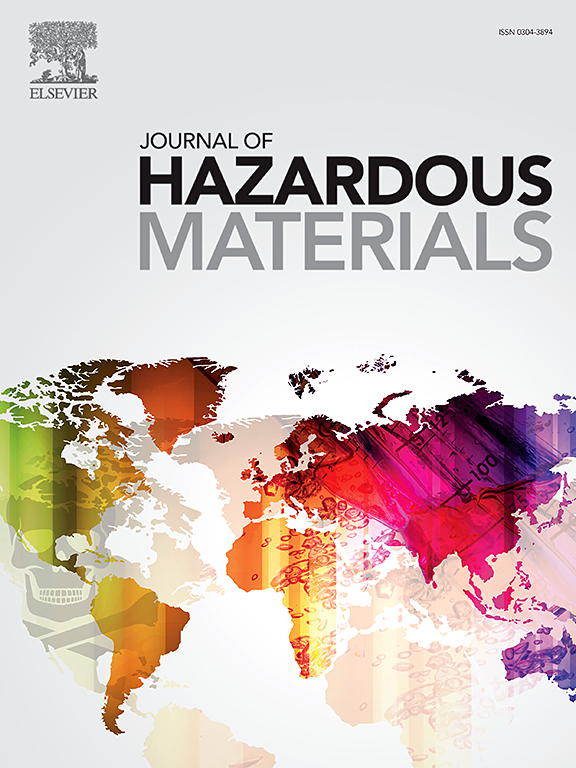盐碱地修复过程中微塑性特性对生态功能、微生物群落迁移及重建机制的影响研究
IF 11.3
1区 环境科学与生态学
Q1 ENGINEERING, ENVIRONMENTAL
引用次数: 0
摘要
盐碱地因高盐碱胁迫而制约农业生产,在农业改良过程中,如农膜残渣和灌溉投入物等引入的微塑料可能对土壤生态功能产生复杂的影响。微塑料作为一种新型污染物,广泛分布于土壤、水体和大气中。然而,微塑料在盐碱土修复过程中与环境的相互作用尚不清楚。本研究通过室内模拟实验,系统分析了PE、PP和PBAT微塑料在沼液修复盐碱地过程中的生态效应。结果表明,微塑料通过改变盐碱土的pH、电导率和有机质分解过程,显著影响碳氮循环相关指标(如氨氮和DOC),并与微生物群落组成和功能途径密切相关。微塑料触发了氧化还原酶活性的激活和重金属抗性/碳氮循环基因的共表达,推动了微生物群落的适应性重建。常规微塑料(PE/PP)在盐碱地中表现出缓慢的表面氧化,其生态效应以物理吸附为主。它们抑制微生物扩散,诱导生态位竞争,选择性地富集烃降解菌Alcanivorax和耐盐碱放线菌Nitriliruptoraceae。其群落聚集主要由随机过程驱动,与对照样品相比,高微塑料丰度(10 wt%)对细菌组成表现出阈值效应。相反,随着粒径的减小,可降解PBAT由于酯键水解而加速降解(C=O官能团从52.50%下降到34.92%),释放分解产物,推动确定性群落组装和重建微生物群落(丰富Proteobacteria, Firmicutes和Halomonas)。PBAT的快速降解可能会加剧短期的生态干扰,而PE/PP的化学惰性则会带来长期的滞留风险。本研究为盐碱地修复中微塑料的风险管理提供了关键数据。虽然微塑料污染可能通过促进微生物代谢活动加速土壤修复,但仍需进一步对盐碱地修复过程中微塑料的安全风险进行评估。本文章由计算机程序翻译,如有差异,请以英文原文为准。

Study on the Impact of Microplastic Characteristics on Ecological Function, Microbial Community Migration and Reconstruction Mechanisms during Saline-Alkali Soil Remediation
Saline-alkali soils constrain agricultural production due to high salt-alkali stress, and the microplastics introduced during agricultural improvement processes, such as through agricultural film residue and irrigation inputs, may have complex effects on soil ecological functions. As a new type of pollutant, microplastics are widely distributed in soils, water, and the atmosphere. However, the interactions between microplastics in the saline-alkali soil remediation process and the environment remain unclear. This study systematically analyzed the ecological effects of PE, PP, and PBAT microplastics during the remediation of saline-alkali soils with biogas slurry through laboratory simulation experiments. The results showed that microplastics significantly affect carbon-nitrogen cycle-related indicators (such as ammonia nitrogen and DOC) by altering the pH, electrical conductivity, and organic matter decomposition process of saline-alkali soils, and strongly correlate with the microbial community composition and functional pathways. Microplastics triggered the activation of redox enzyme activity and the co-expression of heavy metal resistance/carbon-nitrogen cycle genes, driving the adaptive reconstruction of microbial communities. Conventional microplastics (PE/PP) exhibited slow surface oxidation in saline-alkali soils, with physical adsorption dominating their ecological effects. They inhibited microbial diffusion, induced ecological niche competition, and selectively enriched hydrocarbon-degrading bacteria Alcanivorax and salt-alkali-resistant actinobacteria Nitriliruptoraceae. Their community assembly was mainly driven by random processes, and high microplastic abundance (10 wt%) showed a threshold effect on bacterial composition compared to control samples. In contrast, as the particle size decreased, the degradable PBAT accelerated degradation due to ester bond hydrolysis (C=O functional group decreased from 52.50% to 34.92%), releasing decomposition products that drove deterministic community assembly and reconstructed microbial communities (enriching Proteobacteria, Firmicutes, and Halomonas). The rapid degradation of PBAT may exacerbate short-term ecological disturbances, while the chemical inertness of PE/PP poses a long-term retention risk. This study provides key data for risk management of microplastics in saline-alkali soil remediation. Although microplastic pollution may accelerate soil remediation by promoting microbial metabolic activity, further microplastic safety risk assessment during saline-alkali soil remediation is still needed.
求助全文
通过发布文献求助,成功后即可免费获取论文全文。
去求助
来源期刊

Journal of Hazardous Materials
工程技术-工程:环境
CiteScore
25.40
自引率
5.90%
发文量
3059
审稿时长
58 days
期刊介绍:
The Journal of Hazardous Materials serves as a global platform for promoting cutting-edge research in the field of Environmental Science and Engineering. Our publication features a wide range of articles, including full-length research papers, review articles, and perspectives, with the aim of enhancing our understanding of the dangers and risks associated with various materials concerning public health and the environment. It is important to note that the term "environmental contaminants" refers specifically to substances that pose hazardous effects through contamination, while excluding those that do not have such impacts on the environment or human health. Moreover, we emphasize the distinction between wastes and hazardous materials in order to provide further clarity on the scope of the journal. We have a keen interest in exploring specific compounds and microbial agents that have adverse effects on the environment.
 求助内容:
求助内容: 应助结果提醒方式:
应助结果提醒方式:


